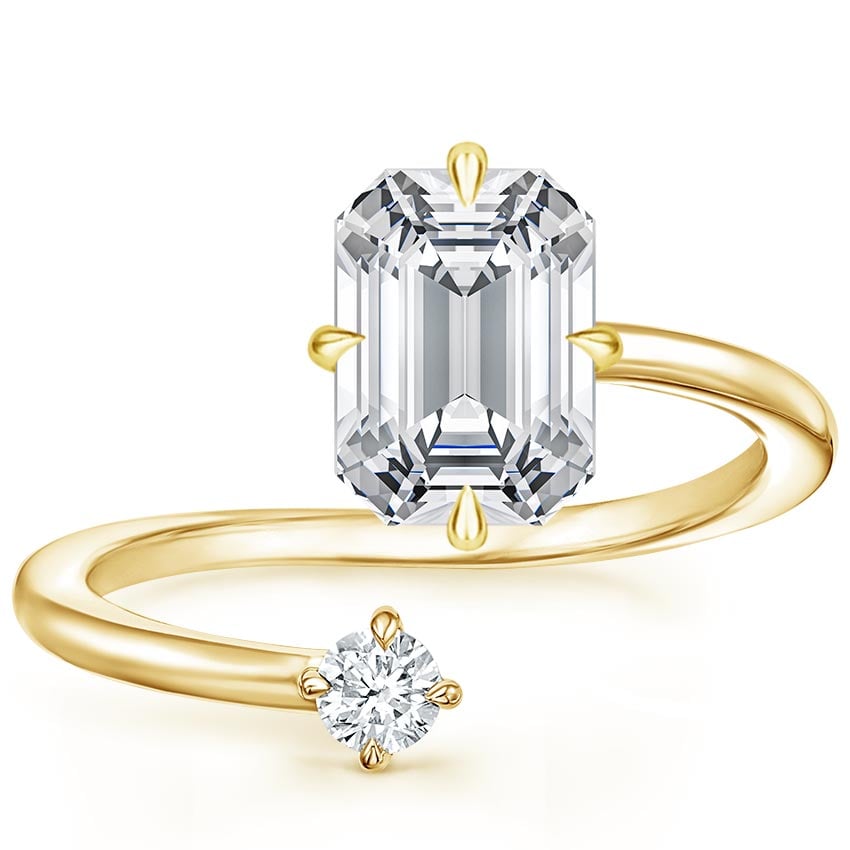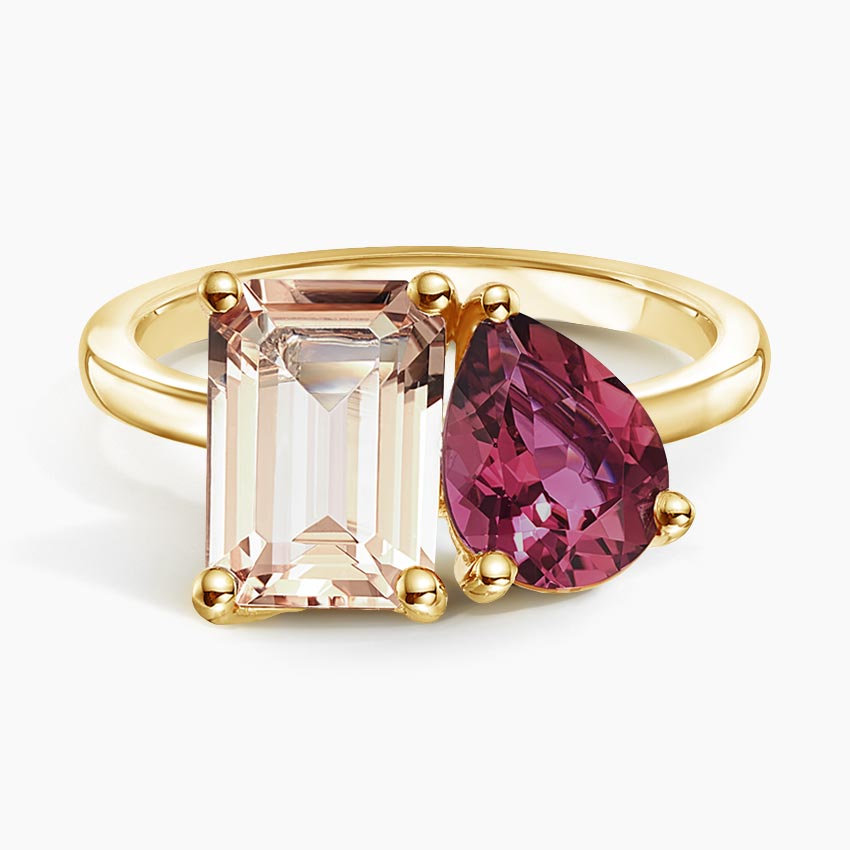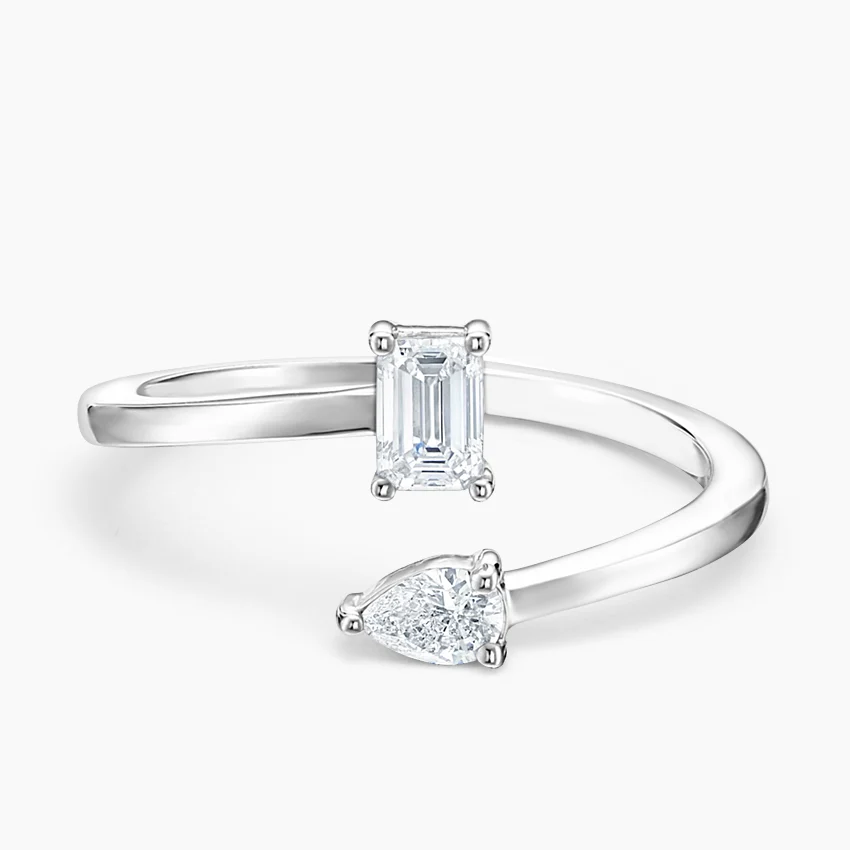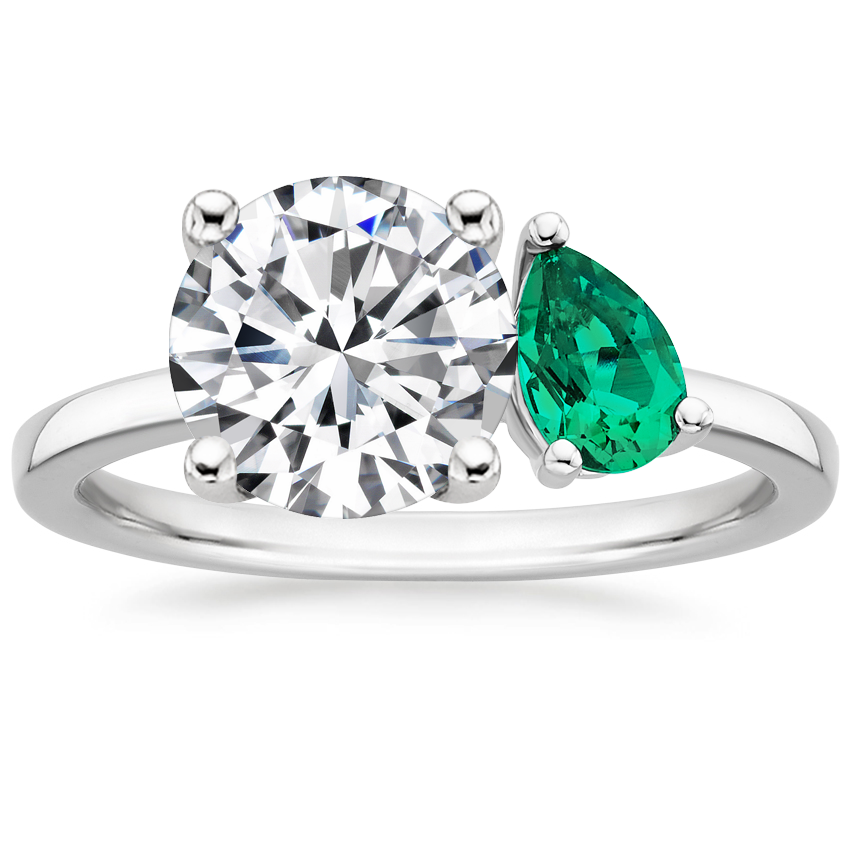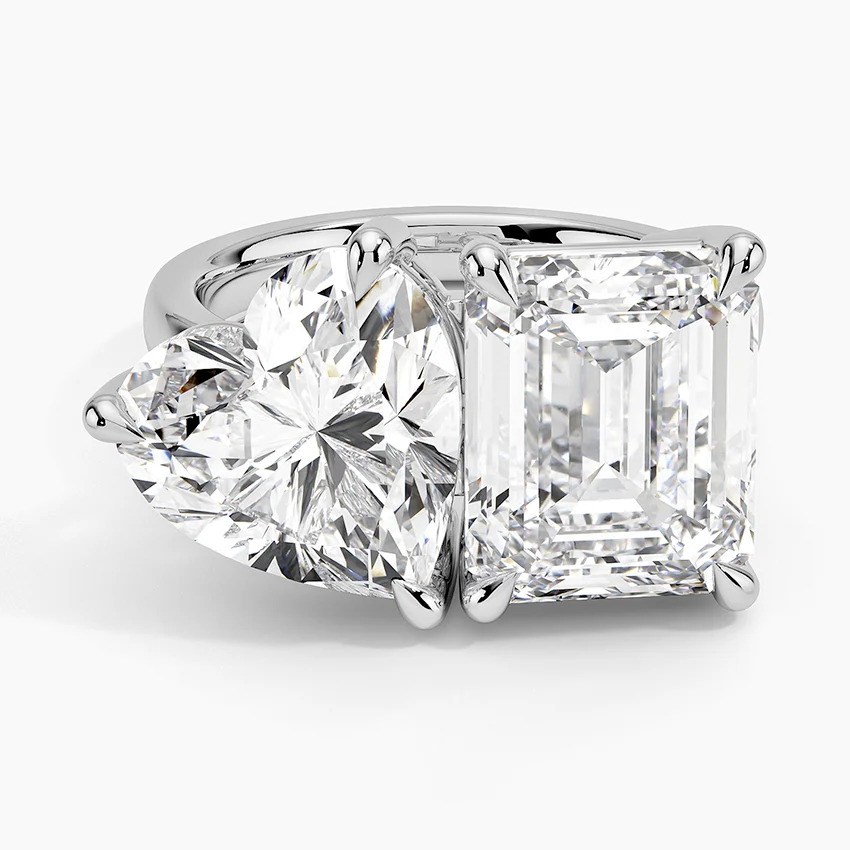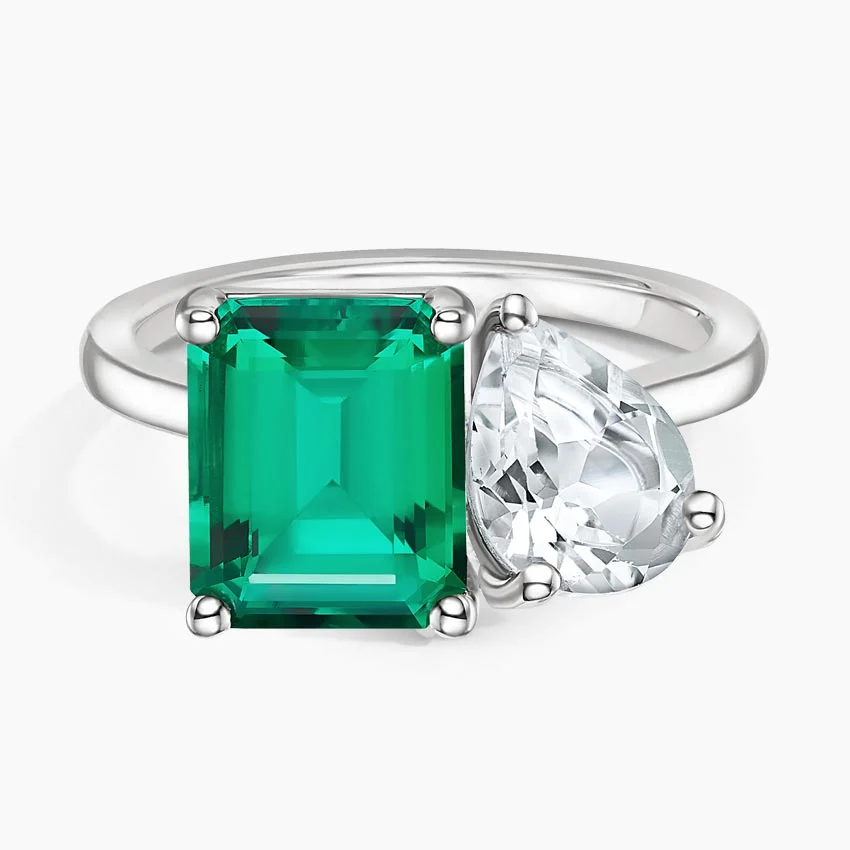
Toi et moi rings are the latest two-stone trend. This jewelry is designed to include more than one gem in a single band: hence their chic ‘toi et moi’ naming. Here’s why these designs are on the rise.
What does toi et moi mean?
Toi et moi means “you and me” in French. This romantic gesture makes toi et moi a classic engagement ring. As a two-stone setting, a toi et moi ring has come to represent the two souls of romantic partners. The gems will sit next to each other on the band as you stand beside your partner for life.
But you can also gift yourself a toi et moi piece. When you’re purely shopping for the luxury of two center stones, a toi et moi ring makes a fabulous, oversized statement piece. It’s the perfect cocktail ring, for example, sharing the “bigger is better” design.
What is a toi et moi ring?
Toi et moi rings feature two center stones in one band. The pairing of colors and cuts is a major opportunity for one-of-a-kind engagement jewelry. With your selection of gemstones, you can give a backstory to the ring symbolizing your future story.
They don’t have to be twin stones because “you and me” can imply many things: maybe they represent your children, the incorporation of an heirloom, or the re-set your engagement ring to add a wedding day gem (or to mark an anniversary).
But don’t need a romantic partner 1) to spoil yourself and enjoy twice the sparkle, or 2) for your jewelry to have symbolism. Mix gem shapes, sizes, and orientations for style’s sake. Or your own sentimental reasons, including family and friendship.
History of Toi et Moi Rings
The history of toi et moi rings began with a romantic gesture of “us against the world.” Around the 18th century, Napoleon’s choice for his first wife wasn’t widely accepted. She was an older, widowed mother. Her former husband had been an aristocrat, while Napoleon was not so much (more on all that below). The two-stone ring symbolized a pact between the couple, an act of devotion that says “I choose you over them/anything” and “We have each other.” Ever since, jewelers have been doubling up on center stones in engagement rings.

Why are toi et moi rings so popular?
Toi et moi rings are one of the biggest engagement ring trends, back in popular demand since being flaunted by Ariana Grande, Kylie Jenner, and more. We get into that in the next section.
Also adding to the new interest in toi et moi is the jewelry wearer’s quest for originality. If this ring is not fully customized, it at least has the look and feel of it. Two stones offer the chance to experiment with endless shapes and colors. Bring in a heart or flower, for example, or enrich your color palette. With so many options to complement or contrast, the odds are your toi et moi ring design is exceptional and unique to you.
Toi et moi rings also have enhanced size and sparkle due to their second stone. That doesn’t hurt this ring setting’s popularity either.
Famous Toi et Moi Engagement Rings
Recently, many of those in the spotlight have given some of their shine to toi et moi rings. But this celebrity engagement ring trend has a lot more history. Here are a few household names now and then who wore toi et moi rings.
Josephine de Beauharnais
- This first one is not exactly an A-lister, but can’t be overlooked. In 18th century France, Napoleon Bonaparte chose love over reputation. Josephine was six years older and already had two children. Napoleon was a rough-around-the-edges army officer. Despite disapproval, they were wed. Just as the gems were entwined, so were toi et moi rings with the concept of “love against all odds.” It all started with two pears: a blue sapphire and a diamond.
Jackie Kennedy
- Who better to reintroduce iconic style to the 20th century than this First Lady? And with her own design, no less. Jackie O paired a 2.84ct emerald-cut emerald with a 2.88ct emerald-cut diamond for her toi et moi engagement ring. A shimmering spiral of smaller diamonds enhanced its shine.
Ariana Grande
- The two stones set side-by-side in this engagement ring are a 3ct brilliant cut oval diamond and a pearl taken from her grandfather’s tie pin. A swoon-worthy display of vintage appeal and personal memento. True class and customization.
Kylie Jenner
- If Josephine won most romantic, Kylie wins most adorable. Her daughter Stormi has a small-scale version of this toi et moi engagement ring for her own tiny fingers. Featuring a 4ct pear shaped diamond and a 4ct radiant cut diamond, we’ve rounded up 5 toi et moi engagement rings like Kylie Jenner’s ring.
Megan Fox
- There’s no shortage of creativity surrounding Machine Gun Kelly’s proposal to Megan Fox. He combined their birth stones to form what he deemed an “obscure heart.” A pear-shaped diamond for him (3ct), and a pear shaped emerald for her (4ct). With a curved pavé platinum band, we’ve gathered 8 unique rings inspired by Megan Fox’s engagement ring.
Emily Ratajkowski
- This ring is credited the most for restarting the toi et moi trend. And understandably so, with a stunning 2ct princess cut diamond placed beside a 3ct pear shaped diamond. A 18K yellow gold band seals the deal.

What to Consider When Choosing a Toi et Moi Engagement Ring
Mismatched and unconventional pairings are trending for toi et moi and beyond, but feel free to opt for the timeless tradition of symmetry. Here’s the design elements you need to know to make your ring work.
Proportion
This has to do with visual balance. Carat: Does one stone dwarf the other? Cut: Do the shapes fit together (generally at least one round always works)? Larger gemstones can overwhelm smaller hands, while smaller stones might look diminished on larger hands. Bezel, prong, or halo settings can affect positioning, including emphasis of one stone over the other. The most important factor is considering depth: if one gem is much taller than the other, it’ll loom over the second stone and be more prone to snagging.
Color
Two white diamonds are fail-safe options as long as the tint and clarity have the same grade (otherwise they’ll distract and invite comparison). But consider striking color in your side-by-side gems. Green emeralds, red rubies, and blue sapphires are go-tos when you want sturdy gems with rich, deep hues. They also harmonize well with white diamonds if you just want one vibrant pop.
The metal finish of your band will act as a backdrop to your stone colors. For cool tones, choose platinum and white gold. For warmth, choose yellow and rose gold.
Shape
Are you looking for elegant symmetry in your stones or do you want a dynamic juxtaposition that feels fresh? Round shapes like ovals and pears sit well with any gem shape. So if you want a bit of edge, but don’t want things so predictably cohesive, bring in an angular emerald or princess cut for your other stone. A combination of “femininity and architecture,” as Emily Ratajkowski put it.
Most Popular Shapes for Toi et Moi Rings
These classic shapes tend to make up at least one half of the two-stone toi et moi. But you can always swap in a motif (nature-inspired petals, etc.) for the second stone. Nostalgic or modern, here are a few starting points.
Emerald Cut
“Sophisticated” is never far behind when discussing this gem cut. Long and linear, but with beveled corners, its clean, strong shape won’t overcrowd.
Pear
This shape makes for a beautiful toi et moi ring. With both a sharp point and soft curves, it’s not only eye-catching, but also completely versatile.
Round
The most popular shape for all rings, it implies everlasting love and commitment. Its brilliance is unmatched, perfect for bringing out the best in a toi et moi.

Most Popular Gemstones for Toi et Moi Rings
While gemstone meanings can play a part in your choice for your toi et moi ring (eg. love and unity), quality should be high on the list. With your gemstones right next to each other, you don’t want a visible difference in their clarity or wear and tear. Prioritize durability if you don’t plan to replace your gems often.
Diamond
When you want “you and me” to be eternal, diamonds have enduring strength and captivating fire, just like your lasting bond. White diamonds are easy to mix and match. They always play up the brightness of a dynamic duo, especially when the other stone is also a diamond. Simply visit our diamond buying guide for the right combination of color and clarity.
Emerald
Emeralds are lush and vivid, guaranteeing your gem pairing will stand out. Said to promote loyalty and emotional healing, they’re ideal for one or both of the two partners represented in a toi et moi ring.
Pearl
A unique choice, pearls are not as tough as other gems, so are often not recommended for a toi et moi ring. They’re softer, so they can chip from the impact and friction of their side-by-side mate. Symmetry can also be difficult (if that’s what you’re after) with natural pieces. Consult a jeweler for a strong setting.
Our Favorite Toi et Moi Rings
Toi et moi rings capture a story, whatever yours may be. To help, Brilliant Earth’s jewelry experts have rounded up their top choices for toi et moi. Shop these rings as they are or feel free to personalize them (which is what toi et moi is all about).
Alma Toi Et Moi Ring
Toi Et Moi Morganite and Pink Tourmaline Ring
Léa Lab Diamond Toi Et Moi Ring
Chic and unique, this design features a pear and emerald-cut lab diamond in a toi et moi look that exudes all things on-trend.
Viridian Toi Et Moi Diamond Ring
This toi et moi ring features a serene lab emerald that brings hues of lush green to a trendy style.
Toi Et Moi Heart and Emerald Cut White Topaz Ring
Romantic yet chic, this toi et moi design features heart-shaped and emerald-cut white topaz in an eye-catching, on-trend look.
Lab Sapphire and White Topaz Toi Et Moi Ring
Trend-forward and unique, this toi et moi ring features a serene blue lab sapphire and a striking white topaz in a cuff style that will never go out of style.
Toi Et Moi Lab Emerald and White Topaz Cocktail Ring
Shimmering in hues of white and green, this toi et moi ring is as on trend as can be and features a topaz and a lab grown emerald as a perfectly matched pair.
Why Choose a Toi et Moi Ring
The biggest reason for choosing a toi et moi ring is style opportunities. The two-stone design of a toi et moi ring is a helpful alternative for those who can’t commit to a single design. Whatever gems you decide will embody yourselves or your chosen meaning…two stones will always sparkle more than one. And together, the center looks more substantial, so in a toi et moi ring, your stones will have an enlarged appearance. To get the most sparkle and size, know the variables that affect each. Research the 4 Cs of diamonds.
Final Thoughts
The gems you bring together in a toi et moi design allow you to express your love your way and combine what’s important to you. Shop jewelry from Brilliant Earth to guarantee that each gem in your toi et moi ring is responsibly sourced.


